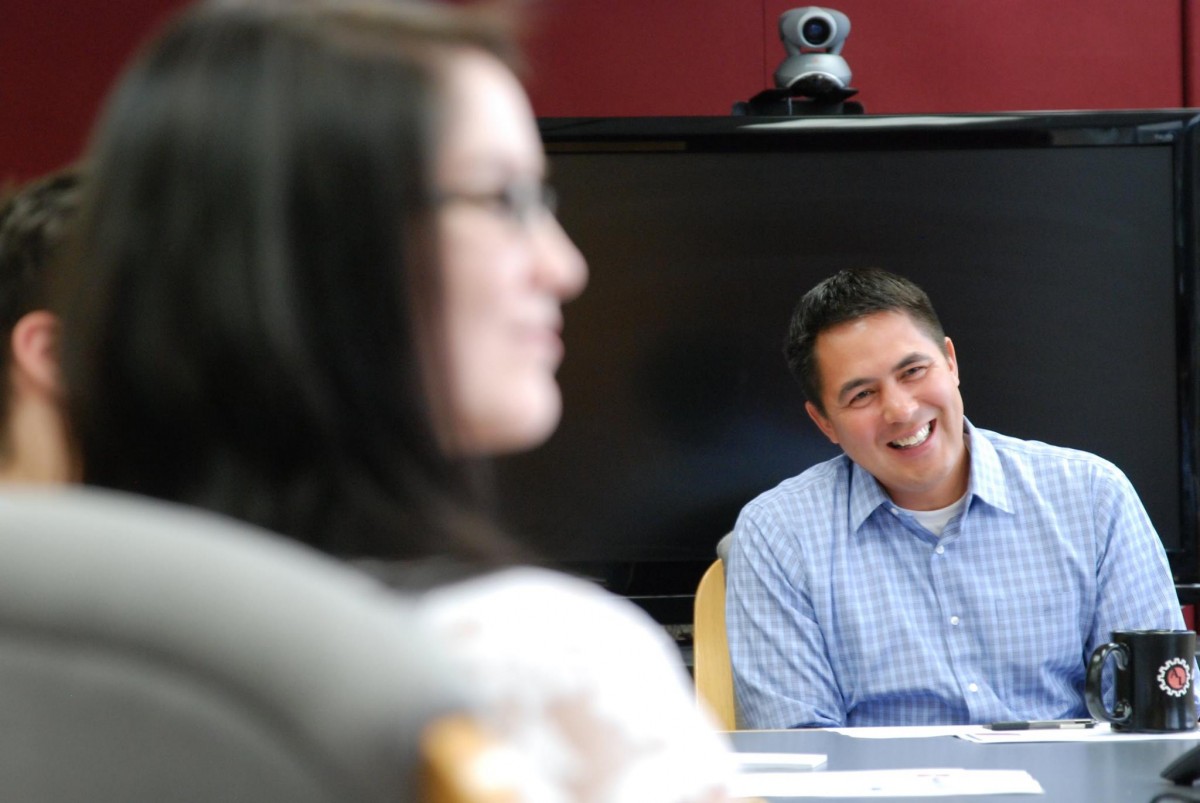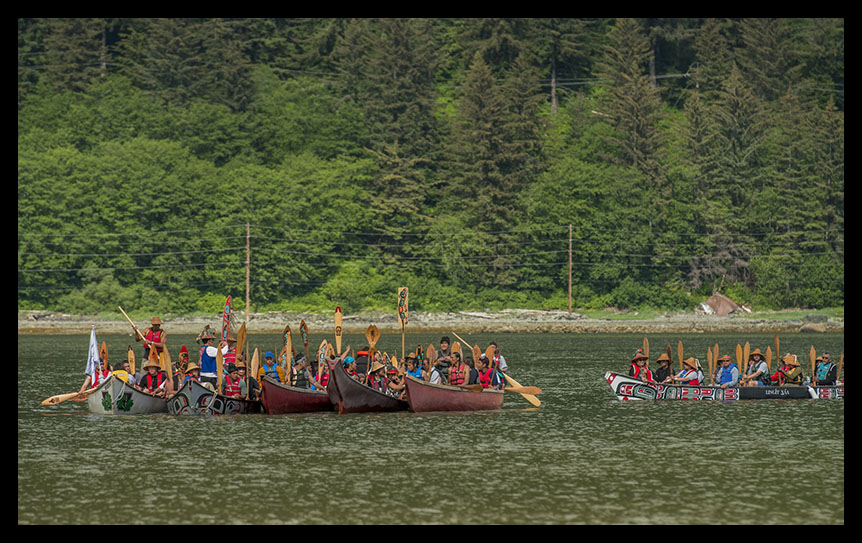Anthony Mallott is CEO of Sealaska, a Juneau-based Alaska Native corporation owned by 22,000 Tlingit, Haida and Tsimshian shareholders. In addition to leading Sealaska, he serves on the Rasmuson Foundation board and The Alaska Community Foundation investment committee. He recently spoke with Philanthropy Northwest CEO Jeff Clarke about his work, as part of our ongoing series of interviews with key leaders in philanthropy from across the region and around the nation.
Jeff: You are both Anthony, the CEO, and Gunnuk, the Tlingit leader. You are of the Tlingit Nation-Eagle Tribe, Tsaagweidí (Killerwhale) Clan, as well as the Koyukon Athabascan, Caribou Clan, a resident of Juneau, Alaska and a citizen of the United States. Can you talk about how fundamental this blending is to you as an individual, your family, your people and the institution you lead?
Anthony: As an Alaska Native, we are taught that a large part of our identity is where you are from, the clan you belong to and who your parents and grandparents are. In fact, in Tlingit society, the group identity is important whereas in Western societies, it’s all about the individual and immediate family. My leadership style is very collaborative as a result. I trust that success comes from working together with individuals and partners who have the skills, experiences and shared goals to create more value than working alone. It also speaks to why I am home in Southeast Alaska, able to participate in my culture, hunt and fish, with a strong want to raise my children within this community and close to family.
I may wear many different hats in my life in terms of work or responsibilities but I am secure in the foundation of my identity as a Native person.
As one of the several thousand younger Southeast tribal members born after the Alaska Native Claims Settlement Act (ANCSA) created corporations in 1971, you are the first Sealaska CEO who is not an original Sealaska shareholder. For those who are less familiar, could you explain the significance of both ANCSA and your appointment?
ANCSA is the land settlement between the federal government and Alaska Natives. Sealaska and 11 other regional native corporations were established by ANCSA. Rather than have sovereign rights over our land, for-profit corporations were formed to provide benefits to shareholders from the land base.
Sealaska represents the Tlingit, Haida and Tsimshian people of southeast Alaska. When ANCSA was approved in 1971, Sealaska enrolled 15,782 shareholders. In 2007, Sealaska shareholders voted and approved to enroll descendants and those who were eligible to enroll in 1971 but were not able to. Today Sealaska represents approximately 22,000 shareholders. I am from the generation of shareholders who were not eligible to enroll in 1971 or after.
I am honored to carry on the values of my parents and grandparents who fought for Native rights. Sealaska is lucky to have other entities in Southeast that share our constituent base and have similar goals to improve the lives of our shareholders or Tribal Members. I’m amazed by a younger group of individuals who are working to save our languages, perpetuate our art and culture, improve tribal and health services, and provide housing opportunities for this shared community. It will take all of us working together and appropriately utilizing all our resources to make a greater impact.
In 2012, the Sealaska board reaffirmed that core Native values would guide Sealaska and its vision for the future, just as the values guided the Tlingit, Haida and Tsimshian people for thousands of years. Gifted by a Council of Traditional Scholars, Sealaska formalized these core Native values as Values In Action. What are the values and how are they embedded in Sealaska’s governance and operating cultures?
Sealaska is guided by four core Native values.
Haa Aaní (Our Land) is a very critical value given that the main impetus of ANCSA was to retain native ownership of our traditional homelands. Land is not a value by itself, but respect and protection for the land is and this drives our focus on land stewardship and sustainability.
One of the most meaningful values we are operating under is Haa Shuká (Our Past, Present, Future), which culturally describes the connection that we have with our ancestors and the responsibility to carry culture, values and strength forward to future generations. We look to our history by understanding what assets were given to Sealaska, what strengths we have, what values we need and want to carry forward, what challenges we face, and we make decisions that aim to benefit both the current and future generations of shareholders. This value speaks to sustainability and holds power for us given the 10,000-year history we have in our traditional homelands.
Haa Latseen (Our Strength, Leadership) is a value that gives indication of the discipline we need to build and utilize our strengths and the responsibility to train and provide leadership so we can achieve our mission of strengthening our people, culture and homelands. It leads us to invest our assets in areas where we can use our strength and competitive advantages for the optimal future benefit of our tribal member shareholders.
Wooch.Yax (Balance, Reciprocity and Respect) represents the balance we expect to create within all relationships, including our relationships with our natural resources. Companies, relationships and projects need to provide value — a main measure of balance — in proportion to the time and capital we put into the efforts. This also speaks directly to the relationship we build with our employees. We must reflect how strongly we value our employees by recognizing their efforts and creating a culture where employee voices are listened too and where they see their efforts leading to progress.
 Upon your appointment last year as CEO, you said, “My focus will be on operational performance and profitability, and on identifying worthy new acquisitions that will achieve our business goals, while aligning with our core Native values.” The business press today celebrates the rise of the social enterprise. Do you consider Sealaska and its 12 peer corporations to be the original social enterprises?
Upon your appointment last year as CEO, you said, “My focus will be on operational performance and profitability, and on identifying worthy new acquisitions that will achieve our business goals, while aligning with our core Native values.” The business press today celebrates the rise of the social enterprise. Do you consider Sealaska and its 12 peer corporations to be the original social enterprises?
It’s very difficult to categorize Alaska Native Corporations as just a “social enterprise” or just a “for-profit corporation," as ANC’s are a unique experiment between the Native people of Alaska and the United States government. Sometimes, we use the term “triple bottom line” because people understand that concept and it comes close to describing our organizations priorities.
We understand that financial performance leads our ability to provide benefit to our tribal member shareholders. We also know that the framework we have of every dollar we make providing a current benefit or being invested to provide future benefits, along with our focus on sustainability and values fits with the growing interest in social enterprises and is valuable for us when forming partnerships and finding business opportunities.
Because of its holistic responsibility to strengthening Tlingit, Haida and Tsimshian people, Sealaska is deeply interested in the health of all communities in southeast Alaska. Talk a little bit about how Haa Aaní, LLC, the Community Development Finance Institution (CDFI) Sealaska recently formed with a mission of developing economic sustainability in Southeast Alaska, is an expression of that purpose. Why a CDFI construct?
Haa Aaní, LLC was created to promote the cultural, social and economic viability of Southeast. As a result, one of its primary goals is to remove impediments to economic growth and build resiliency in the smaller communities in Southeast. Access to capital through the CDFI is one opportunity to create a favorable business environment. The purpose of a CDFI is to create credit and financial services to underserved populations. Haa Aaní, LLC has increased Sealaska’s original investment of $500,000 to the CDFI to nearly $2.4 million. Key funding partners include the Rasmuson Foundation, The Nature Conservancy, the Alaska Conservation Foundation and the U.S. Department of Agriculture. For Sealaska to be successful in Southeast, we want to collaborate with entities that have similar goals and values.
As part of its responsibility to its people, Sealaska established Sealaska Heritage Institute in 1980 to steward, strengthen and perpetuate Tlingit, Haida and Tsimshian culture. Since then, Sealaska has invested roughly $20.1 million in cash and in-kind services. How does the Institute proactively connect the people to their culture in ways that will strengthen and perpetuate it?
The cornerstone of Sealaska’s investment to Sealaska Heritage Institute (SHI) will be the grand opening of the Walter Soboleff building on May 15, 2015. The new building will house offices for SHI staff along with a place to celebrate and learn about Tlingit, Haida and Tsimshian cultures. It will also house ceremonial space, a language-recording studio, and a living history center with distance learning technology. One benefit of this new facility will be shareholder pride. The building is named after beloved Tlingit scholar and leader Dr. Walter Soboleff who has inspired generations and whose legacy will continue to inspire through the new facility.
The essence of Native cultures is manifested through a holistic, community centered approach to living and giving. As you reflect on your years of service with the Rasmuson Foundation board and The Alaska Community Foundation investment committee, could you talk about how who you are, your personal and professional experiences and how you see the world frame the voice you bring to your various governance roles?
I know that there are not enough Native voices in roles like mine, so I take it very seriously. My Native values along with my background in finance give me a unique perspective. I take an analytic approach to oversight and board decision making, but also know the value of passionate employees and try hard to recognize the work of those that are doing the heavy lifting. I also know the value of strong fiduciary standards and the discipline to follow policy when managing investment funds, both of which are key to creating long-term, sustainable benefits.

How are your philanthropic governance roles and voice influenced by what is happening in Alaska? Do you see positive, sustainable impact within communities as a result of Alaska philanthropy?
A healthy and prosperous Alaska is one where all of its citizens do better, especially Alaska’s indigenous people. It takes everyone working together to make this happen and philanthropy is a key component. For me, I see philanthropy in Alaska as playing a key part in perpetuating Native cultures. Sealaska along with the Sealaska Heritage Institute recently celebrated the grand opening of the new Walter Sobeloff building. This beautiful structure would not have been built without the help of the philanthropic community.
How do you and your Rasmuson board and The Alaska Community Foundation investment committee colleagues work to keep pace with and think about change in to order govern proactively?
I incorporate everything I know from all fields of study and experience. Something that works in a completely different field may have some relevance to what we are working on. Through networking, research and a want, not to create a solution someone else has already solved, I am able to keep pace with the latest thinking and ideas around philanthropy and impact investing.
Prior to being named CEO, you spent 18 years in the investment management / global capital markets space. Your understanding of financial capital, capital markets and deal structures, while more common in business, allows you to bring a different lens to your philanthropic work. What are your thoughts about “going beyond the grant” — aligning and deploying more of the balance sheet for mission, if you will — and do you see this as the future of effective philanthropy?
Some of the issues that we face are both urgent and vital. For instance, all three of our Native languages — Tlingit, Haida and Tsimshian — are endangered. We may lose all of our fluent speakers in the next 10-20 years. With the loss of language comes the possible loss of culture. We are also seeing our communities face significant economic headwinds that require new structures, that combine capital, grants and financing, to trigger investment and growth. With these types of pressing obligations, we have to go “beyond the grant” to accomplish our goals. We have no choice but to come up with unique and different ways to fulfill our mission. We do know, though, that we can’t fix these issues on our own and we need partners, both public and private entities, that share our goals and values and who also bring solutions and investment capital.
How does the Sealaska board talk about communication and what, in your opinion, is the role of strategic communication in achieving Sealaska’s mission of strengthening its people, culture and homelands?
Communication is more than a line item expense or a luxury benefit that gets cut when times are tough. It’s essential for the Sealaska board to communicate with the owners (shareholders) of the company and vice versa. It’s also essential Sealaska communicates to the world. If you are not telling your own story, it’s easy to be defined by others. As Native people, most of our history has been written by visiting outsiders. And we are master storytellers so we must always weave this into our communications.
Since the company’s inception in 1971, this has been an ongoing process. One that each new generation must tackle and work out for themselves. Currently, the Sealaska Board understands and defines the identity of Sealaska through our core Native values.
As the foundation of everything we do, our Native values will guide us on our path to improving operations and growing businesses and communications needs to provide our shareholders the comfort that we are making progress and working hard on their behalf.
Photos courtesy of Sealaska. Follow Sealaska Heritage Institute on Twitter: @SHInstitute


